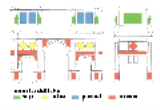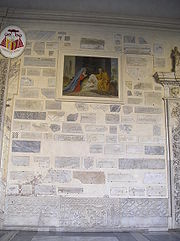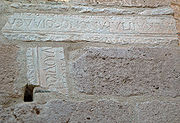
Spolia
Encyclopedia



Late Antiquity
Late Antiquity is a periodization used by historians to describe the time of transition from Classical Antiquity to the Middle Ages, in both mainland Europe and the Mediterranean world. Precise boundaries for the period are a matter of debate, but noted historian of the period Peter Brown proposed...
: Roman examples include the Arch of Janus
Arch of Janus
The Arch of Janus is the only quadrifrons triumphal arch preserved in Rome, across a crossroads in the Velabrum-Forum Boarium. It was built in the early 4th century of spolia, possibly in honour of Constantine I or Constantius II. Its current name is probably from the Renaissance or later and is...
, the earlier imperial reliefs reused on the Arch of Constantine
Arch of Constantine
The Arch of Constantine is a triumphal arch in Rome, situated between the Colosseum and the Palatine Hill. It was erected to commemorate Constantine I's victory over Maxentius at the Battle of Milvian Bridge on October 28, 312...
, the colonnade of Old Saint Peter's Basilica
Old Saint Peter's Basilica
Old Saint Peter's Basilica was the building that stood, from the 4th to 16th centuries, on the spot where the Basilica of Saint Peter stands today in Rome. Construction of the Basilica, built over the historical site of the Circus of Nero, began during the reign of emperor Constantine I...
; examples in Byzantine territories include the exterior sculpture on the Church of Panagia Gorgoepikoos in Athens
Athens
Athens , is the capital and largest city of Greece. Athens dominates the Attica region and is one of the world's oldest cities, as its recorded history spans around 3,400 years. Classical Athens was a powerful city-state...
); in the medieval West Roman tiles were reused in St Albans Cathedral
St Albans Cathedral
St Albans Cathedral is a Church of England cathedral church at St Albans, England. At , its nave is the longest of any cathedral in England...
, porphyry columns in the Palatine Chapel in Aachen
Palatine Chapel in Aachen
The Palatine Chapel is an Early Medieval chapel that is the remaining component of Charlemagne's Palace of Aachen. Although the palace no longer exists, the chapel has been incorporated into the Aachen Cathedral, Germany. It is the city's major landmark and the central monument of the Carolingian...
, and the colonnade of the basilica of Santa Maria in Trastevere
Santa Maria in Trastevere
The Basilica of Our Lady in Trastevere is a titular minor basilica, one of the oldest churches in Rome, and perhaps the first in which mass was openly celebrated...
. Spolia in the medieval Islamic world include the columns in the hypostyle mosques of Kairouan
Kairouan
Kairouan , also known as Kirwan or al-Qayrawan , is the capital of the Kairouan Governorate in Tunisia. Referred to as the Islamic Cultural Capital, it is a UNESCO World Heritage site. The city was founded by the Arabs around 670...
and Cordoba
Mezquita
The Cathedral and former Great Mosque of Córdoba, in ecclesiastical terms the Catedral de Nuestra Señora de la Asunción , and known by the inhabitants of Córdoba as the Mezquita-Catedral , is today a World Heritage Site and the cathedral of the Diocese of Córdoba...
.
Although the modern literature on spolia is primarily concerned with these and other medieval examples, the practice is common and there is probably no period of art history in which evidence for "spoliation" could not be found.
Interpretations of spolia generally alternate between the "ideological" and the "pragmatic." Ideological readings might describe the re-use of art and architectural elements from former empires or dynasties as triumphant (that is, literally as the display of "spoils" or "booty" of the conquered) or as revivalist (proclaiming the renovation of past imperial glories). Pragmatic readings emphasize the utility of re-used materials: if there is a good supply of old marble columns available, for example, there is no need to produce new ones. The two approaches are not mutually exclusive, and there is certainly no one approach that can account for all instances of spoliation, as each instance must be evaluated within its particular historical context.
Spolia had apotropaic spiritual value. Clive Foss has noted that in the fifth century crosses were inscribed on the stones of pagan buildings, as at Ankara, where crosses were inscribed on the walls of the temple of Roma and Augustus. Clive Foss suggests that the purpose of this was to ward off the daimon
Daimon
Daimon is an Ancient Greek word referring to lesser supernatural beings, including minor gods and the spirits of dead heroes.It may also refer to:- People :* Daimon Shelton , professional American football player...
es that lurked in stones that had been consecrated to pagan usage. Liz James extends Foss's observation in noting that statues, laid on their sides and facing outwards, were carefully incorporated in Ankara's city walls in the seventh century, at a time when spolia were also being built into city walls in Miletus
Miletus
Miletus was an ancient Greek city on the western coast of Anatolia , near the mouth of the Maeander River in ancient Caria...
, Sardis
Sardis
Sardis or Sardes was an ancient city at the location of modern Sart in Turkey's Manisa Province...
, Ephesus
Ephesus
Ephesus was an ancient Greek city, and later a major Roman city, on the west coast of Asia Minor, near present-day Selçuk, Izmir Province, Turkey. It was one of the twelve cities of the Ionian League during the Classical Greek era...
and Pergamum: "laying a statue on its side places it and the power it represents under control. It is a way of acquiring the power of rival gods for one's own benefit," Liz James observes. "Inscribing a cross works similarly, sealing the object for Christian purposes".
See also
- Crisis of the 3rd Century
- Roman Empire#Tetrarchy (285–324) and Constantine the Great (324-337)
- DominateDominateThe Dominate was the "despotic" latter phase of government in the ancient Roman Empire from the conclusion of the Third Century Crisis of 235–284 until the formal date of the collapse of the Western Empire in AD 476. It followed the period known as the Principate...
- PalimpsestPalimpsestA palimpsest is a manuscript page from a scroll or book from which the text has been scraped off and which can be used again. The word "palimpsest" comes through Latin palimpsēstus from Ancient Greek παλίμψηστος originally compounded from πάλιν and ψάω literally meaning “scraped...
, the practice of erasing old texts from scarce old vellumVellumVellum is mammal skin prepared for writing or printing on, to produce single pages, scrolls, codices or books. It is generally smooth and durable, although there are great variations depending on preparation, the quality of the skin and the type of animal used...
to write new text. - Diocletian's PalaceDiocletian's PalaceDiocletian's Palace is a building in Split, Croatia, that was built by the Roman emperor Diocletian at the turn of the fourth century AD.Diocletian built the massive palace in preparation for his retirement on 1 May 305 AD. It lies in a bay on the south side of a short peninsula running out from...
, a Roman Imperial palace in Split, re-purposed by later inhabitants as a town.

